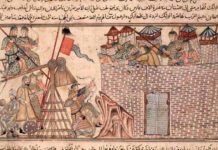The Mekong River cuts a mighty swathe through Cambodia and Vietnam. Yet its impressive width and fertile banks both impress and mislead. The river here gives no hint of the narrows and rapids further upstream which pose formidable barriers to navigation. The French explorers who were so keen to find a commercial route between their Indochinese colonies and the fabled riches of China were to be disappointed.
The Mekong River as a Source of Riches
Among the many young Frenchmen who arrived in the new French colony of Cochinchina in the 1860s was one Francis Garnier. Brave, somewhat reckless and a firm believer in the French colonial enterprise, Garnier quickly developed a fascination with the Mekong River. He argued that it was vital to French interests that the Mekong should be explored, arguing in the pamphlet La Cochinchine francaise en 1864 that such exploration would result in certain riches, allowing France to exploit the resources of the Chinese interior.
The authorities were convinced and an expedition was put together. Lead by Commander Ernest Doudart de Lagree, with Garnier as his second-in-command, the exploration party was completed by another four principal explorers and three interpreters, plus a contingent of French soldiers and Vietnamese militiamen. The expedition left Saigon on 5 June 1866.
Barriers to Exploration of the Mekong
The expedition reached Kratie on 7 July, where they had to transfer their equipment from two steam-powered gunboats into smaller boats in order to continue. It was a manoeuvre they would have to repeat a number of times on the journey.
Passing small settlements and an increasing number of rapids, the expedition slowly made its way up the river. Initially reluctant to admit it, Garnier and the other explorers slowly came to the realization that exploiting the Mekong as a commercial route to China was not feasible. Progress through the Sambor Falls was painfully slow, while Khone Falls, situated just above the modern border between Laos and Cambodia, proved to be nearly insurmountable.
The explorers stopped at Vientiane, at that time still a pale shadow of its former self after its sacking by the Thais in 1828, before heading on to Luang Prabang where they stayed for some months to rest. Travel further upstream was complicated by politics, as the territory through which they had to travel was ruled by a succession of obstructive petty kingdoms.
By the time the expedition reached Jinghong in China the expedition was exhausted and ill. De Lagree, sick himself, decided that evaluating the commercial opportunities of Yunnan outweighed the continued exploration of the Mekong, and the team slowly made their way to Kunming. Garnier made a last effort to follow the Mekong, but had to turn back. By the time he made it back to the others, de Lagree had died, the one casualty of the expedition.
The explorers returned to Saigon on 28 June 1868, having established the course of the Mekong as far as Jinghong and having mapped around 6700 kilometres that had never previously been surveyed. Garnier’s claim that the Mekong could be used to carry lucrative commerce between French Indocina and China had proved wrong, but the river was firmly on the world map.
Source:
- The Mekong: Turbulent Past, Uncertain Future, by Milton Osborne (Allen & Unwin, 2000)








